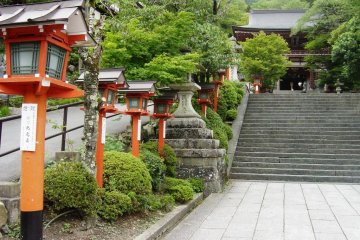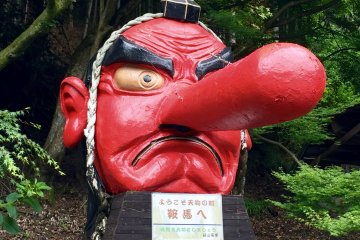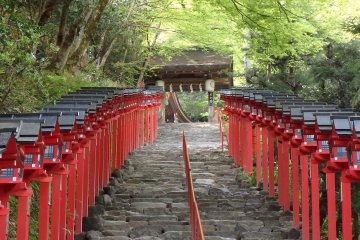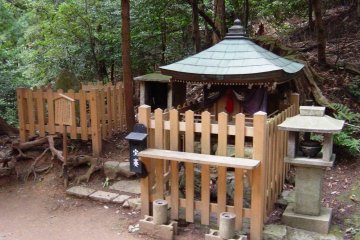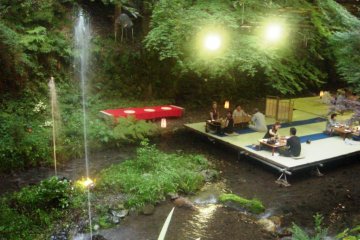The small villages of Kurama and Kibune are located in some lush-green mountain valleys to the north of Kyoto.
Only half an hour by train away from busy central Kyoto, these two villages seem almost as if they are from another world: the pace here is slow and the air is fresh.
For those who like nature, there is a nice hike across the mountains from Kurama Temple to Kibune Shrine. The trek is less than 5 km and it can be completed in about 2 to 3 hours.
Along the way nature lovers can admire some huge Japanese cedars and strangely-shaped Japanese wisteria trees.
The oddly shaped trees and some secluded small temples on top of the mountain create a truly mysterious atmosphere which can be experienced most vividly when you hike in the early morning or in the late afternoon.
The hiking trail starts behind the main building of Kurama Temple.
After a steep climb, you will find Yoshitsune Sekurabe-ishi (Height Comparing Rock) to your right.
Legendary samurai fighter Minamoto Yoshitsune of the Minamoto Clan in Japan's 12th century is said to have measured his height here while, according to legend, training martial arts with a mountain goblin.
Considering the size of the stone, the samurai must have been a small guy, or else the stone shrank over the centuries.
From there a trail leads off to the left. It is called Kinone-sando (Tree Root Path) which leads to Osugi-gongen, the very place where Reiki founder Usui Mikao is said to have fasted and meditated for 21 days before he was given the revelation of Reiki.
Reiki, a hands-on energy healing method, has become a popular alternative therapy these days, not only in Japan but also in the US and in Europe.
While pondering all the legends surrounding this area, be careful not to stumble over the many tangled roots of old cedar trees covering some parts of the path.
From Osugi-gongen make your way back to Yoshihitsune Sekurabe-ishi from where the main trail continues.
Soon you will come to Sojo-ga-dani Fudo-do (Fudo Hall in Sojo Valley) and further down the trail you will reach Oku-no-in Mao-den (Mao Inner Sanctuary).
The Fudo Temple is dedicated to Fudo-myoo, one of the Five Wisdom Kings who are the guardians of esoteric Buddhism in Japan. Being a guardian, he spots an angry face, a sword in his right and a rope in his left hand.
The Mao Temple is dedicated to Maoson no kami, a deity said to have descended to Earth from Venus some six million years ago. Not to be mistaken for Chairman Mao!
There is a legend that a meteorite from Venus fell to earth in Japan breaking off in three parts. One part is said to have landed in the Kurama Mountains.
From the Mao Temple you will be descending the mountain but not before coming across yet another old tree and its tangled branches. This time it is an old fuji (Japanese wisteria tree).
After crossing a small bridge at the end of the trail, you will be in Kibune Village. Turning right, you can visit Kibune Shrine. Turning left and walking down the road, you pass by some restaurants and Japanese-style inns.
There are a number of inns in Kibune where you can stay overnight after a delightful dinner in one of the lantern-lit river-platform restaurants.
These restaurants are called Kawadoko and you literally sit on platforms suspended just above the waters of the river.
They serve a variety of fish dishes but the summer treat to go for here is nagashi somen, some thin noodle served cold.
In the Kurama Mountains the temperature is a few degrees less than in Kyoto in summer and there blows a fresh air. The rippling sound of water from the stream over which the platforms are built also seems to contribute to the cooling effect.
These restaurants are very popular with Kyoto people in summer when the heat in the city is stifling hot.
Make a mental note to come back in summer in case you ventured here during the cooler months, which is perfectly ok, as the trail is accessible year-round.
The right mix of nature, culture, legend and culinary delights invites to exploration away from Kyoto's famous sites.
This hike makes a good half-day or even day trip out of Kyoto and it is excellent for experiencing the Japanese countryside.



